Place value expanded form is one of my favorite place value concepts I teach my 2nd grade students. Not only do I know that it helps with understanding numbers to 1000, but it also helps students when they learn 3-digit addition and subtraction strategies. They are able to use numbers flexibility because they have a foundation of place value expanded form.
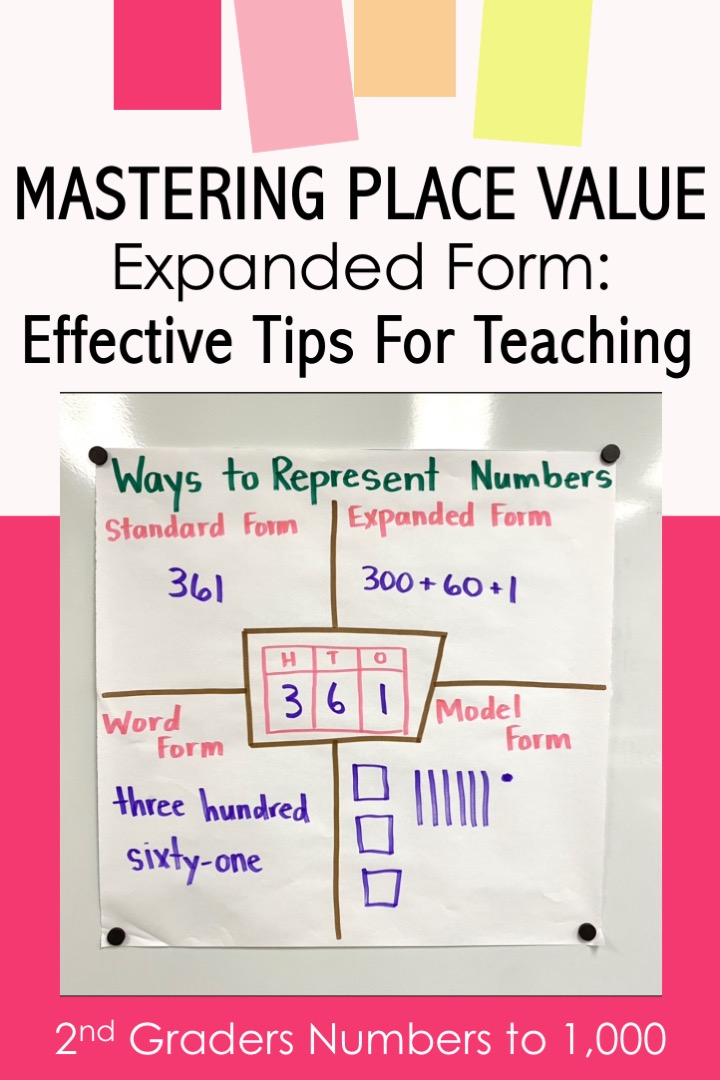
An anchor chart showing place value expanded form is very helpful when teaching all the place value forms of 3-digit numbers.
So today I thought I would share my best tips for teaching 2nd grade students place value expanded form.
But first… If you’re a parent who has a child struggling with math, you’ve got to check out Learner. Learner is an online tutoring platform that sets students up for success. To get started take a short quiz about your child’s needs. Then Learner’s Success Management Team reviews that and matches your child with the perfect tutor. Get your $25 trial here.
Place Value Expanded Form
To introduce writing place value in expanded form, I first model a 3-digit number with base ten blocks. I ask students how many hundreds, tens, and ones are in the number. I put those numbers in a hundreds, tens, and ones chart and I show students how that makes the standard form of a number.
Then I show them the expanded form for place value. I say, “3 hundreds isn’t just 3, it is 300” and “6 tens isn’t just 6, it is 60” and “1 one is just 1!” This helps students see that when a number is in a certain place, it has a certain value. Do you see why they call it place value?
After that, I show students that we can just put a plus sign in between those numbers and that makes place value expanded form. I have them note that with the zeros and the plus signs, this way to write a number is longer than the standard way. That’s why it is called expanded form!
I like to make an anchor chart with all the ways to represent a 3-digit number using place value. The chart has a hundreds, tens, and ones chart in the middle. Then it includes a model of the number where I draw the base ten blocks. Then there is a section for the standard form, the expanded form, and the word form.
I teach all of these forms in one lesson. Here’s how I set up that lesson to give students lots of practice with these forms including writing place value in expanded form.
Place Value Worksheets: Expanded Form and Standard Form
Before I let my students get practice with place value worksheets with expanded form and standard form, we do a few examples together. This makes it so students are more successful with these worksheets.
To do this easily, I use display pages. These help me project examples that we can do as a class, making it great guided practice. And the best part… They match the format of the worksheets so students find better success.
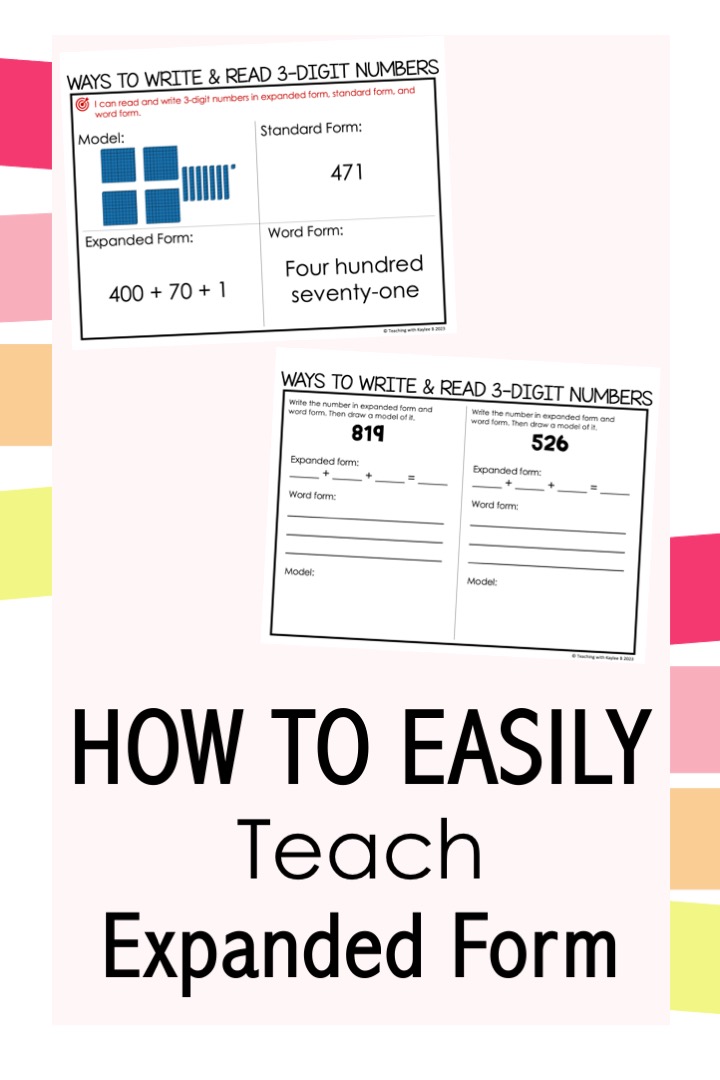
These display pages make teaching expanded form a breeze!
On these display pages, they give us the standard form of the number and we have to write the expanded form, the word form, and draw the model.
Then students are ready to get practice by themselves with the place value worksheets. I like to print these double-sided. Students do the front by themselves, but I am walking around and giving support. I’ll take note of common mistakes and misconceptions. When all students have finished the front side I get their attention and go over those common mistakes and misconceptions. Then I let students do the backside of the worksheet.
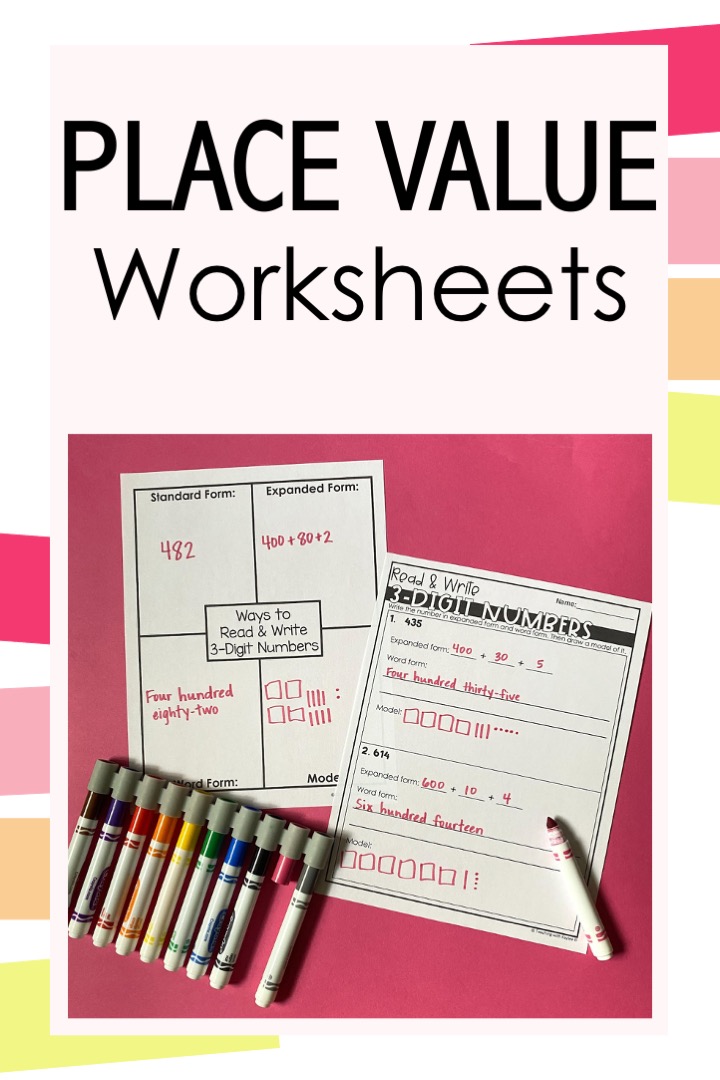
Help students practice writing the different forms of a number with these place value worksheets for expanded form and standard form.
This time I am not walking around giving support. Instead I sit at our classroom table. When students are done, they bring me their worksheet and I look over it with them. I help them fix any mistakes and then give them a big check mark with my favorite smelly markers. Then students put this in their Take Home Folders so that their parents can see how they are doing with learning this concept.
Worksheets are a lot more engaging when you let students use markers to solve. Students never lose their markers with these marker grippers. Find them to use in your classroom here.
As students are finishing, I pair them up with a partner and get them more practice with place value expanded form games and activities.
Place Value Expanded Form Games
I first have students do a scoot activity to practice all of the forms they just learned. I have cards taped up around the classroom and students go with a partner and solve the problems on the cards.
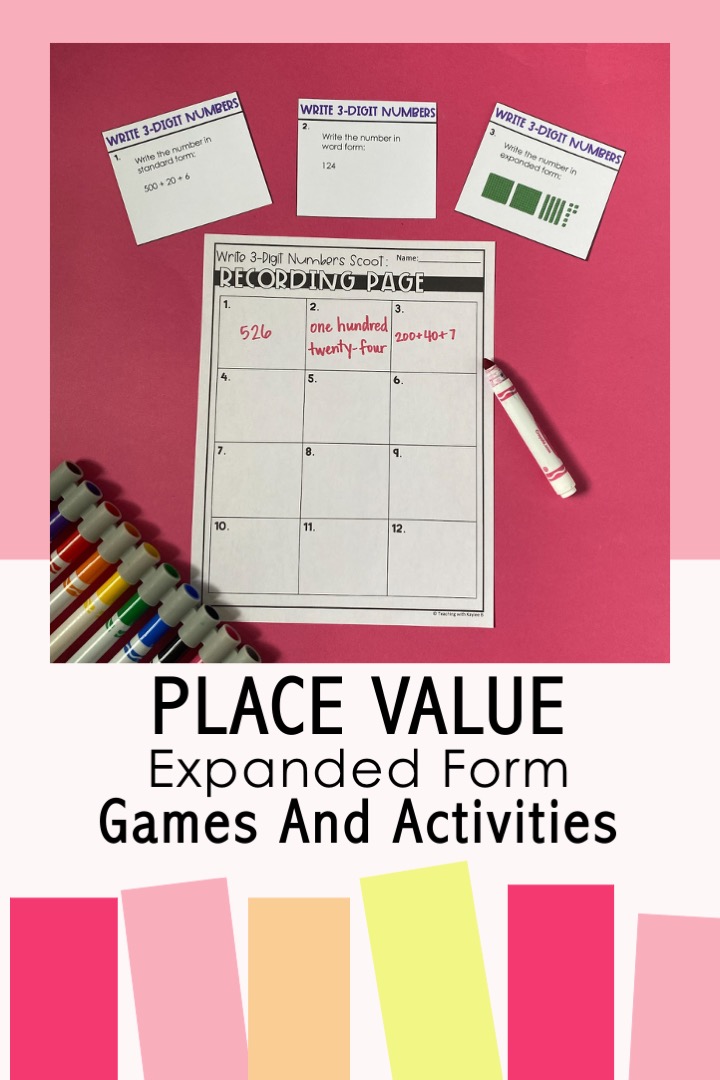
Help students get lots of practice with these place value expanded form games and activities.
These cards give students one form of the number and tell them to write that number in a different form. They record their answers on a recording sheet.
I like having students work with a partner on this because they can provide support to each other. It also gets them talking about the math. As students complete this expanded form activity, I hear them say things like, “I see 5 hundreds, so we need to write 500 first.” I love hearing them tell their partner why they are doing the things they are doing!
After students solve all the cards, I have them check their work with a red pen. I just set out an answer key and then they can fix their mistakes with a red pen. They also put this page in their Take Home Folder so parents can see how they did. I like to have students check their own work because it’s immediate feedback for them, and I don’t have to spend time after school correcting all of these worksheets!
After students finish that, I will have them play another place value expanded form game with their partner. This one is a puzzle! I have all the pieces cut up, they have to work with their partner to match the model to the standard form, the expanded form, and the word form of the number. My students love these math puzzles!
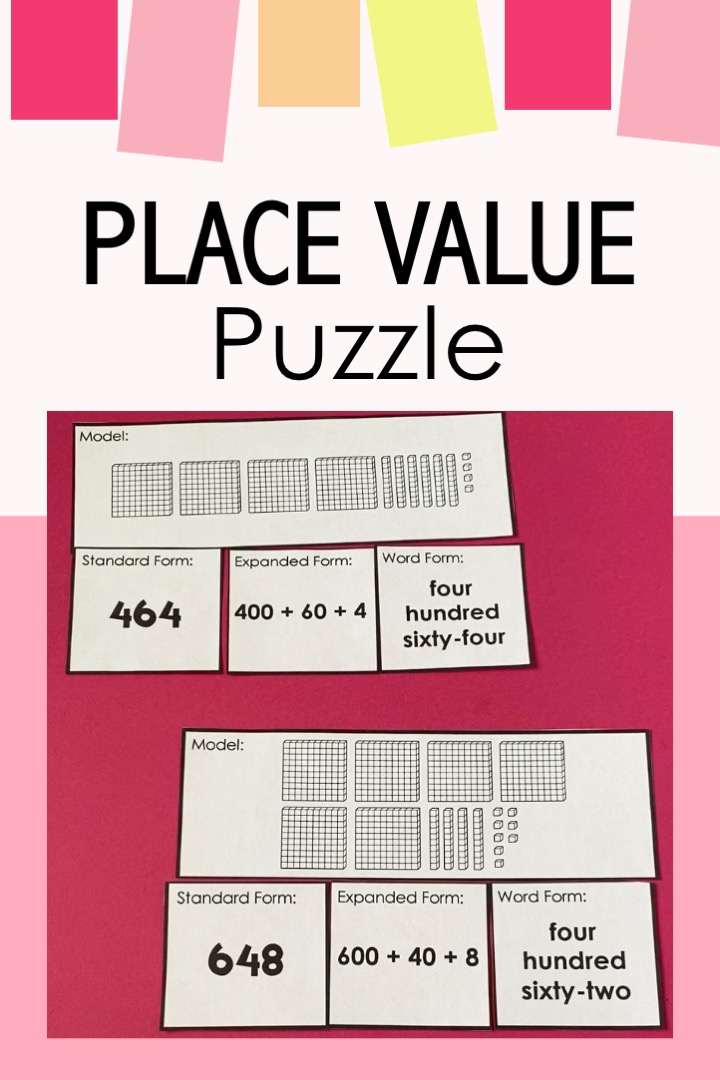
Help students learn the expanded form for place value plus the other ways to represent numbers with this fun Place Value Puzzle.
When students finish, I have them raise their hand. I come over and quickly look over their work and help them fix any mistakes. Then they stack up the pieces, put on the paper clip, and this puzzle is ready for the next students.
After students finish this puzzle, I have them complete an exit ticket by themselves. This helps me see how they understood place value and how to write the different forms of a number. Later that day I will quickly look through these exit tickets and note who may need a little more practice.
To get these students a little more practice, I have them play Place Value War. This is a great place value game that works well for centers or as a fast finisher activity.
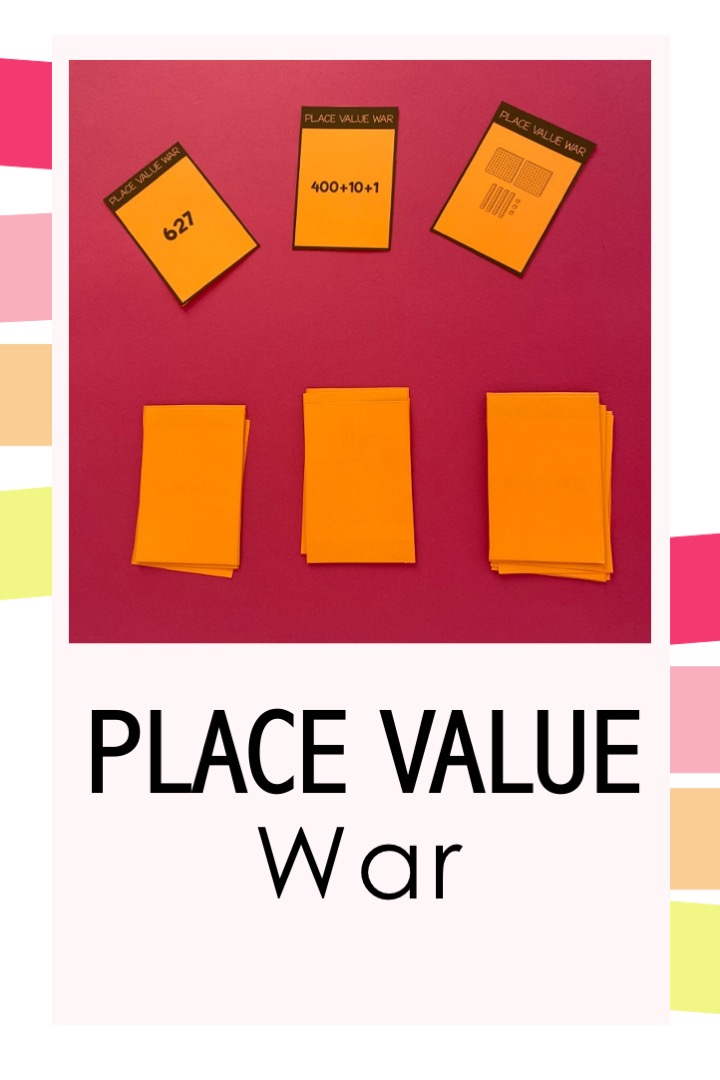
Students learning place value expanded form? Give them fun practice with this concept by playing Place Value War.
To play this, a small group of students pass out the cards to each player until all the cards are gone. Players make their pile neat but do not look at their cards. Players count to 3 and flip over their top card. Then players look at the cards and compare the numbers. The player with the highest number wins that round and puts that round’s cards on the bottom of their pile.
The cards have all the different ways to represent a number, so they are getting good practice with place value expanded form.
Find this Place Value War game to use in your classroom here.
I hope you have been able to get some helpful tips on teaching writing place value in expanded form and the other place value forms to represent numbers to 1,000. It comes down to using models and explicitly teaching the concept. And then of course getting students fun ways to practice!
Find all of the expanded form resources I’ve talked about here.
Learn more about how to teach each 2nd grade place value standard in this blog post: Place Value Standards: How to Best Teach Them to 2nd Grade Students
Teaching 3-Digit Addition Strategies next? Make sure to read this helpful blog post: How 2nd Graders Best Understand 3-Digit Addition Strategies


